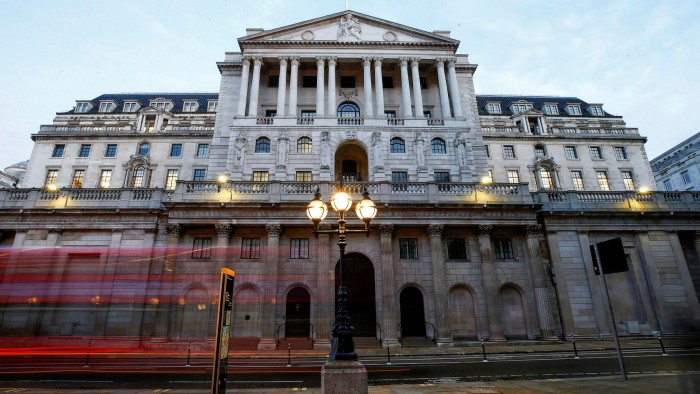BoE expects vaccine-fuelled economic recovery in second half of 2021

Simply sign up to the UK interest rates myFT Digest -- delivered directly to your inbox.
The Bank of England expects a rapid vaccine-fuelled recovery for the UK economy in the second half of this year, but held out the prospect of imposing negative interest rates if the post-lockdown upswing disappoints.
Alongside its quarterly forecasts on Thursday, the central bank said it would force commercial banks to prepare for negative rates to be imposed in six months. It stressed that this was not a sign that the bank’s Monetary Policy Committee thought such a move was necessary.
Andrew Bailey, BoE governor, said the MPC’s central forecast assumed that Covid-related restrictions and health concerns would weigh on economic activity “in the near term”. But he added that the vaccination programme would lead to an easing of conditions “such that gross domestic product is projected to recover strongly from the second quarter of 2021, towards pre-Covid levels”.
While the MPC wanted to be in a position to use negative rates in the months to come, Mr Bailey said “it did not wish to send any signal that it intended to set a negative bank rate at some point in the future”.
Financial markets regarded the BoE’s latest policy statements as a hawkish move, sending sterling higher and raising government borrowing costs.
The pound, which slipped earlier in the day, jumped 0.8 per cent to $1.3676 against the dollar after the meeting as bets that negative rates would be deployed continued to be unwound.
UK government bonds also sold off, although the cost of government borrowing was still negative on bonds with maturities of between one year and five years. The two-year gilt yield rose 0.04 percentage points to -0.04 per cent.
The MPC cut its short-term forecasts as a result of the current Covid-19 lockdown, with output expected to dip 4 per cent this quarter. But it was more optimistic about the outlook for the second half of the year, which it assumed would be boosted by an easing of lockdown restrictions and the rollout of Covid-19 vaccines.
It expects the recovery to make up any loss of output in the first quarter by the end of the year.
It said it still needed to complete the planned £150bn of additional quantitative easing in 2021, under which it creates money and buys government bonds, to keep inflation close to its 2 per cent target.
Martin Beck, lead UK economist at the consultancy Oxford Economics, said: “While the BoE judges [negative rates] are a practical option, they are unlikely to be needed by the time preparations are complete.”
According to Ben Broadbent, deputy governor for monetary policy, the recovery in the forecast was supported by an assumption that interest rates would be negative for a period, but he stressed the effect was “pretty small”.
If the MPC decides in the months ahead that it needs negative rates to boost spending and raise inflation towards the 2 per cent target, it will have taken at least 18 months since the start of the pandemic to put the central bank in a position to implement them.
Karim Haji, head of financial services at advisory group KPMG UK, defended the BoE against accusations it was slow in responding to the pandemic, saying that implementing negative rates was “not an easy switch” for banks.
“It affects how they operate, the products they offer and even their models, meaning preparation will be costly and complex,” he added.
In its forecast of a rapid recovery as the pandemic wanes, the BoE assumed that 5 per cent of households’ accumulated savings would be spent with the rest saved for the longer term.
It also assumed that coronavirus would lower business investment and post-pandemic adjustments would leave incomes persistently 1.75 per cent lower than it had hoped a year ago.
The MPC told staff to assess the best way of tightening monetary policy in the future rather than assuming the central bank would not sell any of the £895bn of assets it has accumulated under its quantitative easing programmes until interest rates had risen to 1.5 per cent.
Its view remained, however, that it would not start tightening monetary policy until there was “clear evidence” that inflation would not again fall below the BoE’s 2 per cent target.
Additional reporting by Naomi Rovnick and Eva Szalay
Comments